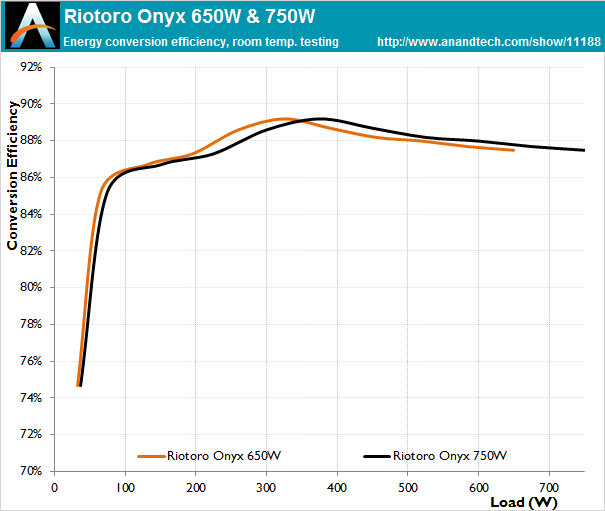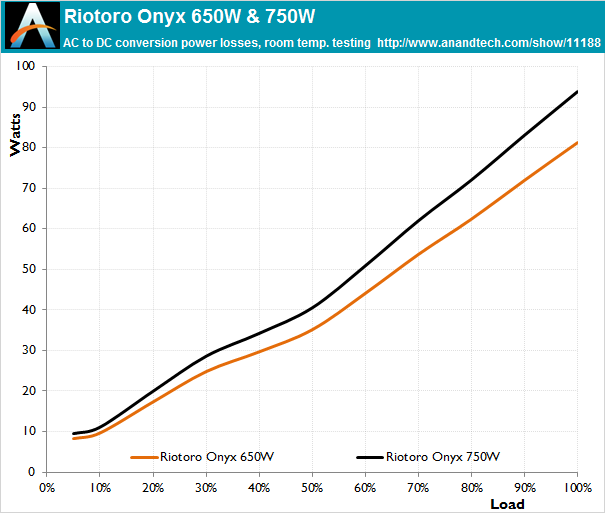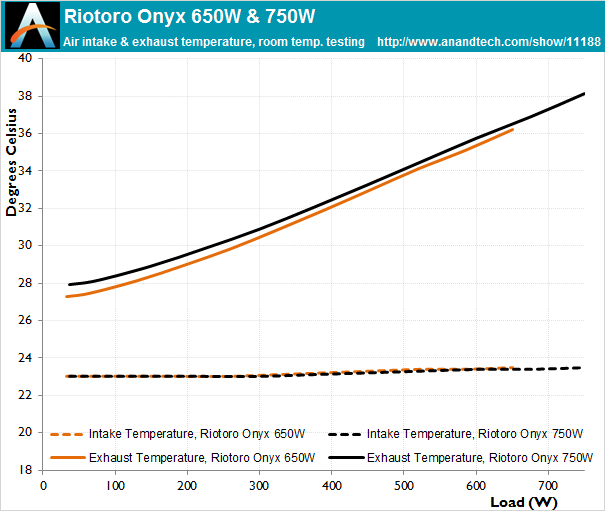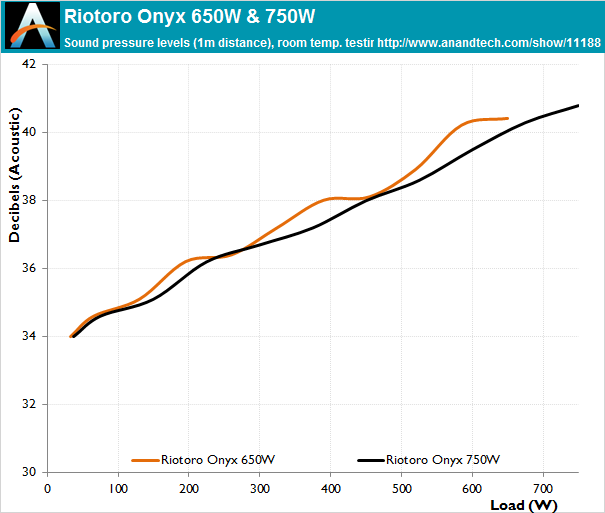The Riotoro Onyx Power Supply Review: 650W & 750W Tested
by E. Fylladitakis on March 23, 2017 10:00 AM ESTCold Test Results
For the testing of PSUs, we are using high precision electronic loads with a maximum power draw of 2700 Watts, a Rigol DS5042M 40 MHz oscilloscope, an Extech 380803 power analyzer, two high precision UNI-T UT-325 digital thermometers, an Extech HD600 SPL meter, a self-designed hotbox and various other bits and parts. For a thorough explanation of our testing methodology and more details on our equipment, please refer to our How We Test PSUs - 2014 Pipeline post.
As expected, the performance of the 650W and the 750W versions of the Onyx is very similar, with the performance curves only slightly leaning to the right of the power axis for the higher wattage model. Both units have exactly the same nominal load range (20%-100%) efficiency, which is 88%. The energy conversion efficiency is excellent for 80Plus Bronze certified units, with remarkably high efficiency readings at lower and higher loads, but the peak efficiency of the units was not high enough to warrant them a better efficiency rating.
The internal operating temperatures of the Riotoro Onyx PSUs are very reasonable, considering the power output and efficiency rating of the units. Their thermal control appears to be very simplistic, with the fans adjusting their speed according to the internal temperature of the units. The fan of the 650W model displays a “ladder” behavior, increasing its speed in steps in relation to the load, where the fan’s speed in the 750W model increases slightly more linearly. This is of no practical consequence to the users though as the sound pressure levels are about the same for an equal power load.















32 Comments
View All Comments
DanNeely - Thursday, March 23, 2017 - link
I thought bitcoin was a bit earlier, must've just been distributed computing projects that did them in. I jumped directly from my GT6800 to GTX260; at which point there were already a decent number of compute projects available to choose from (I'd been running CPU apps via BOINC for several years at that point).kn00tcn - Wednesday, March 29, 2017 - link
xfx may have been the second 'lifetime' or 'double lifetime' brand, though i'm not sure if that was before the amd switch in 2008/2009eriri-el - Friday, March 24, 2017 - link
Don't forget luck playing its usual tricks on us humans. Don't point all ur fingers at the manufaturer/brand alone. My Corsair HX520W is now entering its 10th year of service on my main and only PC. I have been changing and upgrading parts here and there, but I have never seen the need for more power, so I never change it just to see how far it would take me. Maybe one day I'll get something new for more efficiency, but right now I'm just happy it still runs.Sivar - Saturday, March 25, 2017 - link
SeaSonic probably made your Corsair, too.nagi603 - Sunday, March 26, 2017 - link
The first gen Seasonic X series were great, I still have an X400. The latter though... About 1.5 years ago I had a X420 that blew first time I turned it on, and a replacement X400 that refused to turn on about a year later, in a file server that was on maybe 1% of the time. I can only hope the X650 I got instead will last longer.kn00tcn - Wednesday, March 29, 2017 - link
bfg was a dominant nvidia partner like evga is now, to call it some random new company is a complete insult & total ignoranceto not know that many corsair psus are/were built by seasonic is also ignorance
DanNeely - Thursday, March 23, 2017 - link
"The 750W version has two extra PCI Express connectors, plus extra SATA and Molex connectors. Technically, the power rating difference does not really justify such a vast difference on the number of connectors, suggesting that Riotoro simply wanted to differentiate the target group of their two models."The Molex/Sata connectors are almost certainly about differentiation. At potentially 150W per connector 4 6+2 GPU connectors are pushing the limit of what a 650W unit can provide so only putting 2 of them on the smaller one isn't unreasonable. OTOH if they wanted they could've added a single 8 pin GPU connector or 2x 6 pins within the output headroom.
Shadowmaster625 - Thursday, March 23, 2017 - link
Is it that difficult to make a power supply that doesnt give away 10 watts when your machine is idling at 42W?bill.rookard - Thursday, March 23, 2017 - link
It's the span of the wattage that makes it difficult. Not only does the circuitry have to handle generating 50w, it also has to put out 500+ with the exact same design. I'm sure they could design a dual-mode power supply, which has two stages (similar to Arm's BIG.little core designs), but then that's extra components and extra cost, and ultimately for what?Saving 8w of power?
8w of power @ 24/7 is hardly one kw/hr - so it would save you 10c per week, but cost you an extra 50$ for the PSU. That means you'd recoup the savings in 10 years. :)
DanNeely - Thursday, March 23, 2017 - link
The short version is yes. The hardest part of the latest 80+ standard (the first to set a 10% target in addition to the 20-100% ones) is getting the losses from all the fixed power components down, not getting an extra percent or two of efficiency at full load.Broadly speaking your power losses are made up of the sum of a fixed value that's constant when the PSU is turned on and one that grows linearly with power used. Turning the fan on/up and extra losses from hotter parts are why it begins to dip down again at max load.